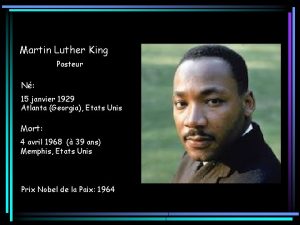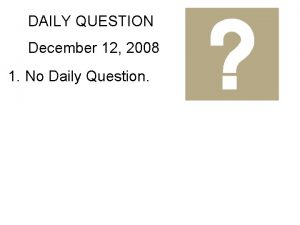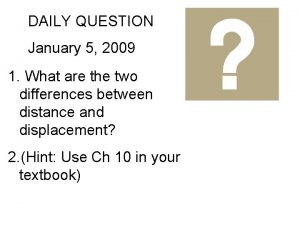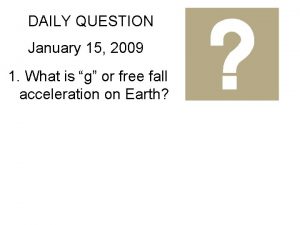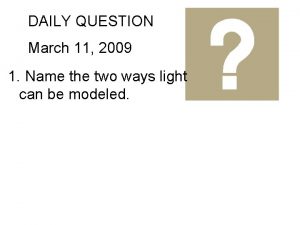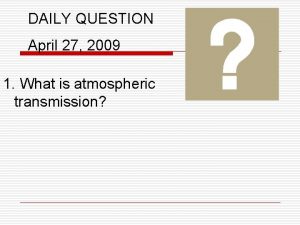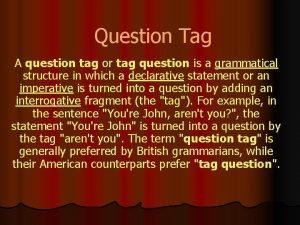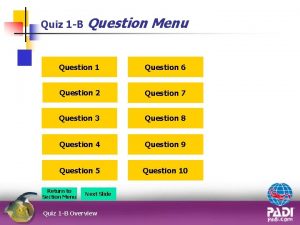DAILY QUESTION January 12 2009 January 13 2009














- Slides: 14

DAILY QUESTION January 12, 2009/ January 13, 2009 1. What is inertia? 2. What are some examples of Newton’s First Law in your daily life? 3. *** If you answered this yesterday, please ignore

Agenda • • 1/13/09 Daily Question Semester 2 Expectations Ch 11 Section 1 Notes Assignments: 1. 11 -1 Review Wksht due 11/14

Semester 2 Expectations – New Bentley Certificates (10 points each) – Be in your seat and working on the Daily Question when the bell rings. – R-E-S-P-E-C-T~ for you, others, and things.

Sir Isaac Newton 1642 - 1727 • Scientist and Mathematician • His accomplishments in mathematics, optics, and physics laid the foundations for modern science and revolutionized the world. • Brain. Pop about Newton and his laws

Newton’s First Law An object at rest remains at rest and an object in motion maintains its velocity unless it experiences an unbalanced force. Sometimes called the “law of inertia”

Inertia The tendency of an object at rest to remain at rest Or, if an object is moving, to continue moving at a constant velocity • All objects have inertia • Mass is a measure of inertia – Softball (smaller mass, has smaller inertia) vs bowling ball (larger mass, has larger inertia)

Newton’s First Law at Work! • Egg 1 versus Egg 2 – Spin Egg 1 • gently place your forefinger on the top of the egg to stop it • then remove your finger immediately after it stops • record any observations – Repeat steps with Egg 2 • record any observations – Using Newton’s First Law, explain your observations and predict which egg is raw and which is hardboiled

Egg 1 versus Egg 2 • The raw egg (Egg 2) should start to turn again. This is because the motion of the liquid within the egg is still going; the force you exerted was not enough to stop both the inertia of the shell and the inertia of the liquid inside of it. If you held the egg longer, enough force would have been exerted to stop the egg completely.

Newton’s First Law at Work! • Coin on a Card – Set an index card over a glass – Put a coin on top of the card – Flick the card sideways off the glass • Record your observations – Try again, but this time slowly pull the card sideways • Record your observations – Using Newton’s First Law, explain your observations

Coin on a Card • When pulled slowly, the coin should not fall into the glass, it should remain resting on the card. The force of friction caused the coin to move sideways with the card.

Newton’s Second Law The unbalanced force acting on an object equals the object’s mass times its acceleration Force = mass x acceleration F=ma

Force • SI Unit of force is the newton (N). – One newton is the force that can give a mass of 1 kg an acceleration of 1 m/s 2 1 N = 1 kg x 1 m/s 2 1 pound (lb) = 4. 448 N 1 N = 0. 225 lb

Using Newton’s 2 nd Law: Finding Force Practice: Zookeepers lift a stretcher that holds a sedated lion. The total mass is 175 kg and the upward acceleration is 0. 675 m/s 2. What is the force? F = ma F = 175 kg x 0. 675 m/s 2 F = 115 N

Using Newton’s 2 nd Law: Finding Force Practice: A baseball accelerates downward at 9. 8 m/s 2. If the gravitational force is 1. 4 N, what is the baseball’s mass? F= ma or m = F/a m = 1. 4 N / 9. 8 m/s 2 m = 0. 14 kg
 Costa's level of questioning
Costa's level of questioning June 2018 chemistry regents
June 2018 chemistry regents 9 months before january 26 2009
9 months before january 26 2009 Examples of compelling questions
Examples of compelling questions Contoh paraphrase
Contoh paraphrase What is a compelling question
What is a compelling question Example of factor relating questions
Example of factor relating questions Question without question words
Question without question words Direct question
Direct question Moderately open question
Moderately open question An asset was purchased for $120 000 on january 1
An asset was purchased for $120 000 on january 1 Meridel lesueur, new masses, january 1932
Meridel lesueur, new masses, january 1932 April 2006 calendar
April 2006 calendar January 15 1929
January 15 1929 How old are you peter weatherall
How old are you peter weatherall













